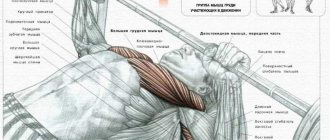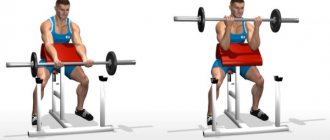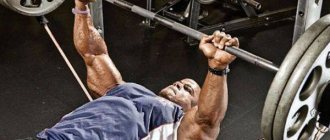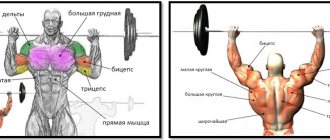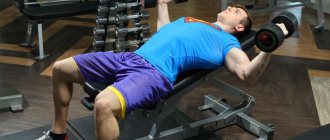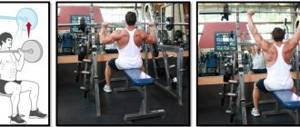At first glance, the bench press may seem like a fairly simple exercise, especially when compared to the deadlift or squat. I took the barbell with a wide grip, lowered it to my chest, raised it - technically nothing complicated. The devil, as always, is in the details. The width of the grip, the trajectory of movement, the speed of the press and even the placement of the feet can play a decisive role in distributing the load on the pectoral muscles, reducing the effect of the exercise to zero and sending the bencher from the gym to the emergency room. In order not to waste time behind the barbell, it is better to insure your body against head mistakes. Aware - armed.
#1 Emphasis on the positive phase of the movement
Error
You can often find that athletes slowly lift the barbell and then quickly throw it down . Some are so carried away by this technique that they turn their chest into a kind of trampoline, from which the barbell bounces vertically upward.
With this technique, the bar goes through the negative phase almost like lightning, and it is during this phase that the muscle fibers do a tremendous amount of work resisting the force of gravity. The stretching increases, the muscles experience overload. The result is microdamage that activates the growth mechanism of muscle tissue. Without an emphasis on the negative phase, it will not be possible to achieve such an effect in full, so the effectiveness of the exercise will noticeably decrease.
Solution
How to do a bench press with a barbell correctly, taking into account the emphasis on the negative phase? Everything is extremely simple. As the bar moves downwards, you need to continue to resist the weight of the bar until the lowest point and feel the muscle tension until the bar is at the minimum distance from the chest. Here you need to take a short break and begin the positive phase of the exercise.
The main rule of bench presses is that in the negative phase the barbell should lower a little slower than it rises in the positive phase. Violation of the speed limit will immediately affect the effectiveness of the exercise.
Bench press on a horizontal bench
Technique
Starting position: lying with your back on a horizontal bench. The buttocks are pressed tightly to the surface of the bench, and the entire foot is placed on the floor:
- take the barbell with an overhand grip slightly wider than shoulder width;
— take a breath and slowly lower the barbell to chest level, controlling the movement;
- Squeeze the barbell and exhale at the end of the movement.
Performing the exercise
What muscles work
This exercise develops the entire pectoralis major , pectoralis minor , triceps, anterior deltoid, serratus and coracobrachialis muscles.
#2 Straight trajectory
Error
One of the most popular mistakes is the straight trajectory of the bar during the exercise. This technique does not provide the opportunity to develop maximum strength and can injure the shoulder joint.
If the bar moves in one plane over the top of the pecs (photo on the left), at the bottom point the angle at the elbows will be exactly 90 degrees. The upper part of the shoulder will press the rotator cuff against the acrominoclavicular joint, which can result in pain in the shoulder joint , cause inflammation and, in some cases, result in injury.
To level the load on the shoulder joint, the bar must be lowered to the lower part of the pecs. However, a straight trajectory (shot in the middle) will also be a mistake here: at the top point above the chest, the barbell is not easy to hold . As a result, working with heavy weight will become problematic.
Since a straight trajectory is undesirable, performing presses on a Smith machine is not recommended.
Solution
Ideally, the barbell should move strictly diagonally. At the lowest point it will be at the level of the lower pectoral muscles, and at the upper point it will be above the deltoids. This technique will give you good weight control and minimal chance of damaging your shoulder joint.
Bench Press Variations
Depending on the range of motion of the barbell, the position of the bench and the athlete on it, there are many types of bench press.
Classic bench press
The classic bench press is performed in a horizontal position on a bench. The initial position of the barbell is on outstretched arms, after which it is lowered with the bar onto the chest and, after a short pause, returns to its original position. There is an alternative option for performing this exercise, when the bar takes its initial position on the stops in the frame at the level of the athlete’s chest, and then from this position it is pressed up until the arms are completely aligned and returns to the stops again.
The press, in which the legs, unlike the classic one, are not on the floor, but are pressed against the body on a bench press, is excellent for those who have problems with the spine due to strong deflection during the exercise according to the classical scheme.
The so-called “touch” press is performed similarly to the classical technique, only the pause during which the bar touches the chest should be as short as possible. However, competitive technique in powerlifting involves squeezing the barbell up only after a command that allows it to be done.
The rack press reduces the range of motion of the barbell using limiters that are installed at the level of the athlete's chest in the power rack. This training option is convenient in cases where the athlete is just recovering from an injury or when there is no partner nearby who can back up.
There are a class of exercises on an inclined bench, including:
- The incline bench press most uses the upper part of the pectoral muscle, in this case it is the execution technique that plays a big role, not the weight of the barbell. At the same time, the greater the angle of inclination of the bench, the more load falls on the anterior deltoid muscles;
- Bench press with an incline strengthens the lower part of the pectoral muscle; to achieve maximum effect, it is advisable to straighten your arms as much as possible at the top point, however, this exercise is quite dangerous, so it is better to use insurance, and for those who suffer from increased intracranial or intraocular pressure or have problems with cardiovascular -vascular system, it is better to avoid this exercise altogether;
The reverse grip press mostly loads the top of the pectoral muscle and the shoulder joint, while removing the barbell from the racks on your own is quite inconvenient and dangerous, so it is better to perform this exercise with a safety net.
The advantage of bench pressing with dumbbells instead of a barbell is that in this exercise the apparatus can be lowered much lower, which allows you to use the muscles being trained to a greater extent.
The bench press with a back arch due to the decrease in the trajectory of the barbell allows you to take on more weight, while the load is redistributed to the lower chest. This exercise is not recommended for those who have back problems.
Pressing on a Smith machine is relatively safe due to the fact that the bar moves vertically in the frame, but the development of some strength indicators during such training remains incomplete.
The close-grip press improves the shape and size of the triceps, and also engages the triceps, deltoids, and upper pectoral muscles. The distance between the fingers when gripping the bar directly in this exercise should be no more than 40 cm.
The wide grip press is often used in powerlifting to train the chest push. This exercise is characterized by a small range of motion of the stay due to its close proximity to the chest, but this allows for greater weight and greater emphasis on working the pectoral muscles, rather than the triceps, as with a close-grip bench press. This exercise is effective for growing the chest and shoulders.
The French press is recommended to be performed using a curved barbell in order to remove the stress from the forearm. This exercise is aimed at developing the triceps. It is performed with a narrow grip, but at the same time the bar of the barbell is lowered not to the chest, but to the head. In this case, the legs should rest solely on the floor, and not on the bench, so as not to lose balance and avoid injury.
#3 Incorrect position of the shoulder blades
Error
Often, during bench presses, all attention is directed to the correct position of the elbows and wrists, and many simply forget about the back muscles. However, the position of the back plays a key role in distributing the load to the pecs. The shoulder blades are especially important: if you don’t bring them together during presses, you will transfer the load from your pecs to your shoulders .
It all happens as follows. If the shoulder blades do not come together, this is immediately reflected in the pectoral blades, which stop arching forward. An insufficiently arched chest during bench presses leads to a series of consequences: the trajectory of the movement increases, and the bar and forearms travel more distance per repetition. At the lowest point, a significant part of the load falls on your shoulders and you risk “breaking” them when working with heavy weight.
Solution
How to do a bench press with a barbell correctly so that your shoulders say “thank you” to you? Even before starting the presses, make sure that your shoulder blades are brought together . Imagine that there is a pencil sandwiched between them. Try to keep your shoulder blades in this position throughout the entire set of barbell presses. At the top point, the position of the shoulder blades should not change even though it is quite difficult to keep them retracted.
Throughout the entire exercise, your pecs should be convex like lenses. Don't worry that this will shorten the trajectory. The price is only a couple of centimeters, but your shoulders will be reliably protected from overloads.
Technique for performing the classic bench press
Starting position: lying on a bench, head, shoulders and buttocks touching it, feet shoulder-width apart and pressed to the floor, shoulder blades retracted.
Next, you should remove the barbell (by yourself or with the help of a partner) from the racks with straight arms and lower it down.
The end point should be the lower area of the chest, approximately in the area of the nipples. The projectile should only slightly touch the chest, and not rest on it.
While moving, make sure that your forearms always remain perpendicular to the floor. The hands should not be twisted too far back, as this places excessive stress on them and can disrupt the balance of the movement.
The elbows should not be spread too far and pressed too close to the body; their optimal position is 45 degrees in the horizontal plane.
Lowering the barbell should be done quite slowly, while lifting it is carried out with a more explosive movement. Inhalation is done while lowering, exhalation is done while lifting.
Additional recommendations
1) A strong back arch, known in powerlifting as a “bridge,” is undesirable in the bodybuilding press. The bridge aims to maximize the weight lifted by distributing the load throughout the body and taking some of the load off the target muscles, which is called a cheat.
In addition, a good bridge requires its installation with a trainer and sufficient stretching, and therefore, during independent exercises aimed at muscle growth, its use can be hazardous to health. Allow only a slight, natural arch of the back.
2) The need to warm up is obvious; in the bench press, you should pay attention to warming up not only the pectoral muscles and shoulder joint, but also warming up the feet and wrist joint, as well as the lower back; a significant part of the passive load is placed on them.
3) Progression in both strength indicators and muscle mass is possible by including auxiliary exercises in the training program that work the muscles involved in the bench press in different ways. These could be dips, bench presses and dumbbell flyes, pullovers, etc.
4) The increase in weight on the bar should be gradual: there will be greater benefit from adding a kilogram per week than from adding five kilograms at a time at the end of the month. It is easier for the body to adapt to such a smooth increase in loads, but it may not be able to cope with a sharp jump in weights, and the result will be stagnation.
5) It is advisable to have a partner who will help remove the barbell from the racks, provide insurance and be able to correct the technique while observing the process from the side.
If you do not have a partner and you are working out alone, it is not recommended to attach locks to the barbell, since if you fail to lift the weight, you should always be able to drop it to the floor.
Runtime errors
Failure to follow the technique and recommendations inevitably leads to errors in the bench press. Let's briefly list them:
- Lifting your heels off the floor and your feet “walking” along it.
- Non-adducted shoulder blades, as a result, loose shoulders on the bench and excessive activation of the trapezius muscles.
- Forearms and hands thrown back.
- Unstable elbow position.
- Cheating with a powerlifting bridge, especially if the athlete does not engage in special strength training.
- Neglecting warm-up, belaying and other safety precautions.
- Too sharp an increase in weights, a fanatical desire to constantly increase them at the cost of developing the technique of execution.
- Lifting the pelvis off the bench
#4 Lack of arching in the lower back
Error
A flat back during bench presses is not a critical mistake, but it can still reduce the effectiveness of the exercise. The deflection in the lower back allows you to better expand the pecs outward, which causes them to stretch at the lowest point . Moreover, in this position it is easier to control the weight, so experienced bodybuilders often deliberately increase the arch in the lower back.
Solution
During bench presses, only the buttocks, shoulder blades and the back of the head should be in contact with the bench. 1-2 centimeters between the lower back and the bench .
When performing heavy bench presses, arching your lower back may pose a risk of back injury. To prevent this from happening, we recommend increasing the load gradually and not taking too much weight. To be on the safe side, you can take a weightlifting belt , which will reduce the likelihood of injury and stabilize the body during exercise.
Classic bench press compared to the bench press with a moving apparatus[edit | edit code]
Results of measuring the electrical activity of working muscles in the bench press
Translation from English and adaptation of the text: Andrey Zavyalov
Sports scientists at California State University published an article in the journal Strength and Conditioning Research on the effectiveness of the bench press with moving equipment for the pectoral muscles.
Classic bench press with movable implements
The experiment involved 20 students who had experience in strength training for several years. Subjects performed three consecutive repetitions of the bench press. The researchers attached electrodes to the muscles involved in the bench press so that they could be tracked as they tensed during the exercise. The students were required to do one repetition of the classic barbell bench press and one repetition of the bench press with an unstable apparatus: the researchers attached 16 kg of weight to each end of the bar with a rope, causing the weight to swing as the press was performed.
results
The graphs display the results of measuring the electrical activity of working muscles in the bench press with a weight of 80% of the one-repetition maximum (1RM). The subjects also performed the exercise at 60% of 1RM, but the results were approximately the same in both cases. The researchers recorded slightly more electrical activity in the muscles during concentric and eccentric movements when lifting unstable weights. Therefore, it can be assumed that the unstable version of the exercise stimulates muscles slightly more effectively than the classic press, but the differences were not statistically significant.
Conclusion
“The lack of significant differences in muscle stimulation between stable and unstable loads in the bench press may allow the use of unstable loads to add variety to training programs,” the researchers concluded. “Additionally, since some sports, such as football, are characterized by unstable loads, the use of exercises with moving weights can provide a new training stimulus.” “However, the lack of significant difference between the results of this study suggests that there are no advantages or disadvantages to using an unstable load in the bench press.”
#5 Incorrect grip
Error
One of the most serious mistakes that can cost you your health. It consists in taking the bar with a monkey grip , when all the fingers are on one side (photo on the left). It would seem that this position of the fingers seems justified: the bar is as close as possible to the lower part of the palm above the radius. This technique helps you cope with bench presses easier and even lift more weight. However, there is one “but” that covers all these advantages.
When the fingers are on one side, there is a risk of the bar falling off . This happens so quickly that even a dozen backups cannot save you. The bar may fall on your chest or throat, causing internal bleeding or simply suffocating you. It is for this reason that using a monkey grip for bench presses is often called a suicide grip , and you can only use it after making a will.
Solution
Take the barbell so that your thumb and the other four fingers are on opposite sides of the bar. Squeeze the bar tightly so that it does not move around in your palm. This way you will have complete control over the weight and protect yourself from the bar falling.
Try to hold the barbell so that the bar is closer to the bottom of your palm (photo on the right). This technique will help to avoid bending in the wrists when the working weight is too heavy.
Why is exercise dangerous?
Despite its popularity, the bench press is also one of the most traumatic exercises. The fact is that here the athlete has to work with huge weights, which, if the technique is not followed, can lead to injury.
In addition, you need to know one more aspect. Although you can progress quickly, you should artificially slow down your performance gains. Even if your muscles are growing quickly and can already cope with new weights, your joints may not be ready for this, which, due to their structure, take longer to adapt. As a result, sooner or later you can damage your shoulder joints.
In addition, this exercise always requires the help of a partner, especially on the last approaches. It should control the movement of the bar so that it moves exclusively in the vertical plane, as well as help lift the weight off the racks and support you as you complete the last reps.
Another important factor is warming up. Before pressing the barbell, you need to pay enough attention to it. For young gym goers, this may not yet play a huge role - the muscles and ligaments may still be strong and elastic. But not everyone is so lucky, and for some athletes, the very first training session using this exercise can cause a lifelong injury to the shoulder joint.
#6 Lack of safety net
Error
One of the most critical mistakes during bench presses is the lack of a spotter who can come to the rescue during a failure repetition. Without a safety net, the barbell can easily land on your chest, neck, or head. It can all end in intensive care, as in the case of the monkey grip.
Solution
To be on the safe side, you can use special racks that will prevent the barbell from falling during a failure repetition. Ideally, the racks should be wide enough so that the bar cannot miss them - this also happens.
two horizontal benches instead . If they are too low or high, then you definitely need a belayer. Ask anyone in the room to help, tell them how many repetitions you are going to do and which of them you think might be a failure. Choose your belayer carefully so that it doesn’t turn out to be a kid who will land on you along with the barbell in case of failure.
Have you decided to perform bench presses without racks and a spotter? Here are some tips on what you can do in an emergency:
- The surest way to avoid unpleasant consequences is to quickly call someone for help . Compared to the no-lock press or belly roll technique, this is the safest way to avoid injury.
- Try to press without locks on the bar . In case of an emergency, tilt one part of the bar so that the plates fall to the floor. After this, you can repeat the same with the other side of the brief. When dropping weights, try to hold the bar very tightly, as it can fly upward like a catapult.
- If you press with locks, if it is impossible to squeeze the bar, you need to carefully lower it onto your chest and try to roll it down to your lower abdomen , tensing your abs. Once this happens, slide your body towards the counter. The bar should be on your hips. Calmly lift your torso and transfer the barbell from your hips to the bench. Roll the bar closer to the rack and place the bar on it using a deadlift.
How to increase weight on bench press?
There is probably not a single person who goes to the gym who would not like to increase their bench press performance. Many people have been doing this exercise for years with the same maximum weight, without being able to add even a couple of kilograms. Using these simple tips will help you increase the number of plates on the apparatus.
- From the outside it may seem that the bench press is an exercise that involves only the muscles of the chest and arms. But this is far from true. The work involves a large number of stabilizer muscles, as well as core muscles. If they are poorly developed in you, then you can’t hope for a good result in the bench press. To fix this, they need to be strengthened. Namely, perform such basic exercises as squats and deadlifts. These are basic exercises that strengthen the muscles of the legs, back and core.
- Having good and developed shoulder muscles (deltoids) will give you extra stability during the press. Therefore, they must be developed. The best exercises for this would be a standing barbell press (military press) or a seated dumbbell press. It's who likes it more.
- After your partner has helped you remove the barbell from the racks, do not hold it in the up position for long. Start pressing right away.
- Move the barbell in a straight line. This is the shortest distance between two points. Many famous bodybuilders practice bench presses along a curved path, which increases the load on the muscles. Our goal is to increase weight, so we use a straight line.
- Visualization. Visualization plays a significant role in the bench press. Imagining how we push the weight that we have not yet pressed, it is much easier to translate these thoughts into reality. It’s not for nothing that many successful athletes say that their main weapon is their brain.
If you follow these simple tips, you will reap two important benefits:
- Healthy spine.
- Developed pectoral muscles.
#7 Incorrect position of the fifth point
Error
Often many people lift their butt off the bench during bench presses. In essence, this technique is cheating, reducing the effectiveness of the exercise. Due to the elevated position of the body, the trajectory of the barbell movement is noticeably reduced. As a result, your pecs work at half strength.
Solution
The fifth point should fit snugly against the bench before starting the exercise.
This position must be maintained consistently throughout the repetition, even at the highest point. At the same time, do not forget about the arch in the lower back and arched chest.
Execution technique
As with any basic strength exercise, when preparing for the bench press you need to do a general warm-up. You should start the exercise with warm-up sets with an empty bar or light weight, which will warm up the core muscles and protect yourself from injury.
After the barbell is removed from the racks with the help of a spotter, it must be balanced to neutralize the side-to-side sway. To do this, just hold it on outstretched arms. After this, you need to bring your shoulder blades together and begin to slowly lower the barbell towards your chest, controlling its movement.
You should make sure that the athlete takes the correct position on the bench, which involves four points of support, namely in the occipital region, at the level of the shoulder blades, pelvis and feet. You should look directly upward and not try to follow the barbell during the exercise.
When performing the bench press, you need to ensure that the deflection in the lower back is moderate in order to avoid injury. The shoulder blades should be retracted, the shoulders should be directed back, and the chest should be directed forward. Legs should be spread wide apart and confidently rest your feet on the floor. By squeezing the glutes, the lifter also gains additional stability on the bench and relieves unnecessary tension from the lower back. The bar should be kept closer to the base of the palm, and not to the fingers, and the elbows should be in line with the hands.
It is important to monitor the trajectory of the barbell movement so that at the first stages of squeezing it is not directed towards the legs; for this it is better to direct it vertically or in the direction of the collarbones. When choosing the optimal weight for the bench press, you need to remember that less weight is used when building muscle mass, and more weight is used when building strength.
An interesting recommendation concerns experimenting with the thickness of the neck. For example, after working out for a certain amount of time using a thicker bar than an Olympic barbell, you may feel that the exercises with standard-sized bars become easier. It is also equally important to find the optimal grip width that makes it possible to achieve maximum results, based on the individual characteristics of the athlete. So, for those who have well-developed triceps, a narrower grip is suitable, and for those whose strength is the strength of the chest muscles, a wide grip is suitable.
As with any other exercise, it is important to breathe properly when doing the bench press. It is recommended to take a deep breath when the barbell is on top or resting on the frame stops, lowering the barbell, it is better to hold your breath, and you need to exhale when pressing the barbell up.
#8 Weight set incorrectly
Error
Sometimes athletes set the same weight on both sides of the bar, but the layout of the plates on each side is different . For example, on the right there are pancakes of 5, 10 and 15 kg, and on the left there are 2 pancakes of 15 kg each. It would seem that the weight on the right and left is balanced, but everything is not so simple. Due to the different set of plates, the center of gravity of the bar shifts. The load will be distributed unevenly, and performing presses will be much more difficult.
Solution
Try to hang the weights on the bar symmetrically so that the center of gravity of the bar is strictly in the center. The pancakes must be the same in weight and size and be securely fastened with locks.
#9 Incorrect wrist position
Error
During bench presses, gravity inevitably pulls the bar and the weight down. If your wrists are bent backwards, all that force will stretch the wrist muscles. Such a mistake will significantly increase the risk of losing control of the weight or getting a wrist injury , which will take you out of the training process for a long time.
Solution
The wrists need to be aligned so that they are a continuation of the forearms: the radius bone should be strictly under the bar . If this cannot be done, it is necessary to reduce the working weight.
#10 Legs “dance”
Error
Many people, while doing a bench press, have their legs twitch as if they were being attacked by a maniac strangler. As a result, the position of the body becomes unstable : there is a risk of falling off the bench along with the weight and “earning” a trip to the nearest hospital.
Another mistake could be incorrect placement of the feet: they are too narrow to the bench, in front of or behind the knees. In all of these cases, the support of the legs does not provide stability to the core, which makes performing presses more difficult and risky.
Solution
How to do a bench press with a barbell correctly in terms of leg position? Before you start the exercise, check your feet. Ideally, they should be exactly under the knees - only in this position will the body be in a secure position throughout the entire set of exercises. Also, your feet should not point perpendicular to the bench. Your toes should point in the same direction as your knees.
Some athletes use the technique of placing their feet on a bench: this option is only suitable for advanced athletes and is associated with a high risk of losing balance and ending up on the floor with the barbell.
Basic chest exercise
The classic barbell press, lying on a bench with your back, is one of the basic exercises, that is, exercises that, when performed, involve the muscles of the whole body in an effective way. When bench pressing, the main muscles that receive the load are the pectoral muscles. Slightly less load falls on the shoulders and triceps.
The barbell bench press is a key upper-body exercise that builds a strong chest and a broad, athletic back. Note that this exercise, in terms of the technique of its execution and the muscle groups involved in the work, is very close to the movements that an athlete makes when flexing and extending his arms in a lying position. The difference is that the bench press allows you to load the body with additional weights, which leads to stronger muscle development.
#11 Bar tilt
Error
A common mistake beginners make when bench pressing is tilting one side of the bar , as a result of which the bar is no longer parallel to the floor.
This mistake is largely due to the fact that one hand is usually more developed than the other. Also, bench presses involve the work of a large number of muscles, and coordinating their work is not so easy. Unsynchronization of movements leads to uneven lowering of the bar. It begins to fall to one side, loading the pectorals differently.
Solution
Try not to look at your right or left hand, but direct your gaze strictly in the center . Take the bar so that your hands are at the same distance from the center: the notches will help you with this.
If the problem cannot be solved, try training with less weight and working on the tenc.
Practical tips for implementation:
- When doing a bench press while lying on a horizontal bench, try not to arch your back. As a rule, powerlifters do backbends in order to lift more weight. This seriously injures the spine. Our goal is to develop muscles while avoiding possible injuries. Therefore, there is no need to bend your back. During the bench press, your pelvis and shoulder blades should be on the bench, and your legs should be on the floor, or they can be raised up. If you still have space between your lower back and the bench.
- Location. When you lie down on the bench, the bar should be at eye level. If you lie too far away, the racks will interfere with your ability to perform the exercise, and if you lie too close, it will be difficult for you to pick up and place the barbell on the racks. Thus, you need to lie down so that the barbell is at eye level. In this position, you will be comfortable picking up the barbell, doing a press, and placing it back on the racks.
- Grip width. When doing a barbell press, the grip width should be such that at the bottom of the exercise (when the barbell is near the chest) the angle at the elbows is 90 degrees. If you perform a barbell press with a narrow grip, the main load shifts from the chest muscles to the triceps, and then the pecs will not receive the proper load. If you take the barbell too wide, the range of motion will decrease and the deltoids will take away part of the load. You must choose your own grip so that it is comfortable and suitable for you.
- While performing this exercise, you must work within the amplitude. This means that you do not need to fully straighten your elbows. If you do this, the load from the pectoral muscles will go to the triceps. When you do this exercise, stop the barbell a couple of centimeters before full extension; this will maintain tension in the muscles and give a more noticeable effect.
- Breath. When doing a barbell press, you definitely need to breathe. How? When you lower the barbell, inhale, and raise it as you exhale.
- Movement speed. You need to lower the bar approximately twice as slow as you raise it. In no case is it the other way around. Why?:
- When you lower the bar slowly, tension is maintained in the pectoral muscles, and this way you work the muscles better.
- If you lower the barbell too quickly, you may not be able to hold it and it will hit your chest, which can lead to injury.

